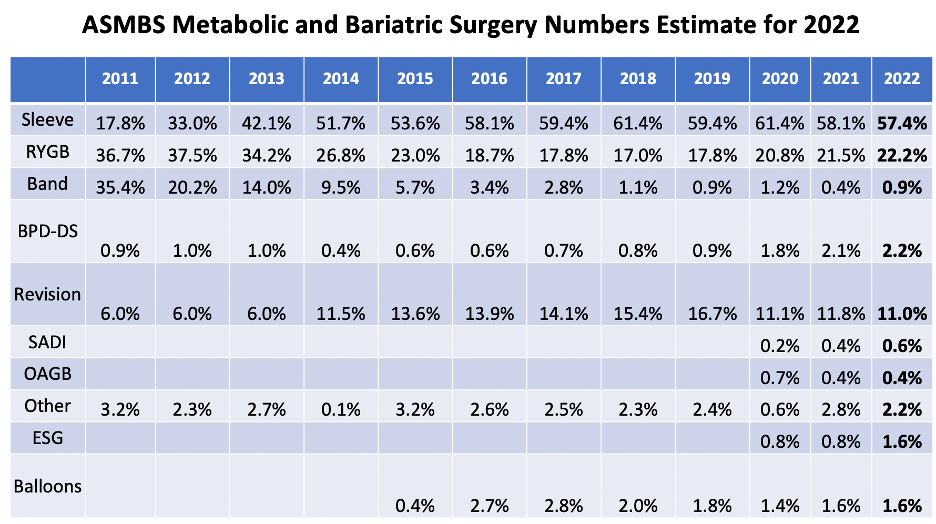Navigating the Shifts in Bariatric Surgery: A 2022 Perspective
Introduction
The dynamic field of bariatric surgery continues to evolve, reflecting the ongoing challenges and scientific advancements in addressing obesity and metabolic disorders. This article reviews the changes in the metabolic and bariatric surgery landscape in the United States for the year 2022, following up on our previous decade-long analysis.
Sleeve Gastrectomy Maintains the Lead
Sleeve Gastrectomy, with its minimalistic approach and substantial impact on obesity-related comorbidities, has maintained its position as the most prevalent procedure, albeit with a minor decrease in its share to 57.4%. This marginal decline does not overshadow its dominance in the bariatric space, as the procedure continues to be favored for its balance of simplicity and efficacy.
RYGB: A Resilient Contender
The RYGB has witnessed a slight uptick in its percentage, rising to 22.2%. This suggests that, despite the competition from other procedures, RYGB holds its ground as a reliable option for patients, particularly those with severe obesity-related conditions that may not be as effectively managed by other surgical methods.
The Band's Unexpected Comeback
After a consistent decline over the years, Adjustable Gastric Banding saw a surprising revival in 2022, doubling its share to 0.9%. This could indicate a renewed interest in revisiting and possibly optimizing this technique for specific patient demographics.
BPD-DS and Revision Surgeries: Consistent but Cautious
The BPD-DS procedure continues its steady climb, reaching 2.2%, reflecting its niche but significant role in the bariatric surgery spectrum. Revision surgeries have slightly decreased to 11.0%, possibly suggesting improvements in primary procedures' success rates and patient adherence to post-operative guidelines.
Innovative Procedures Gaining Ground
SADI and OAGB, newer entrants in the field, have shown varying degrees of adoption. SADI has increased its share, while OAGB remains stable — both procedures are still in the early stages of acceptance within the medical community. ESG, a non-invasive alternative, has notably doubled its numbers, suggesting a growing patient preference for less invasive interventions.
Stable Ground for Gastric Balloons
Gastric Balloons maintained their standing at 1.6%, indicating a stable yet modest position in the treatment arsenal against obesity. This stability could be a sign of the procedure finding its steady state among the available options.
Conclusion
The year 2022 has unfolded with subtle yet telling shifts in the preferences for bariatric surgery procedures. Sleeve Gastrectomy and RYGB continue to be the mainstays, with the former slightly waning but still leading the pack.
The resurgence of the Adjustable Gastric Band, albeit small, alongside the steady rise of BPD-DS, signals a diverse landscape of procedures catering to different patient needs and clinician judgments.
The rise of ESG points to an increased demand for less invasive procedures, reflecting a patient-driven push towards interventions that balance efficacy with convenience and reduced recovery times. Meanwhile, the consistent figures for Gastric Balloons suggest a solidified role within the non-surgical weight loss domain.
As the bariatric surgery field moves forward, it appears to be diversifying its portfolio of procedures, each finding its niche based on a combination of effectiveness, patient preference, and long-term outcomes. The slight dip in revision surgeries could imply that the quality and longevity of primary surgeries are improving, which would be an ideal trend for both patients and healthcare systems.
In conclusion, the 2022 data indicates a maturing bariatric surgery landscape. It is becoming more responsive to individual patient profiles, with a sustained overall growth pattern. This nuanced evolution showcases the field's adaptability and commitment to offering tailored, effective treatments in the fight against the obesity epidemic. The coming years will likely see further innovations and refinements, as the medical community continues to enhance the safety, effectiveness, and accessibility of bariatric surgery options.
Future Outlook
With obesity rates still on the rise, the demand for bariatric surgery will likely increase. Continuous improvement in surgical techniques and the introduction of new technologies will further shape the field. The long-term success of bariatric surgery will also hinge on comprehensive pre- and post-operative care, emphasizing the importance of multidisciplinary approaches to ensure sustainable weight loss and improvement in comorbidities. The data from 2022 serves as a checkpoint in this ongoing journey, signaling the trends that healthcare providers and patients alike must consider as they navigate their options in the pursuit of health and well-being.





































































































